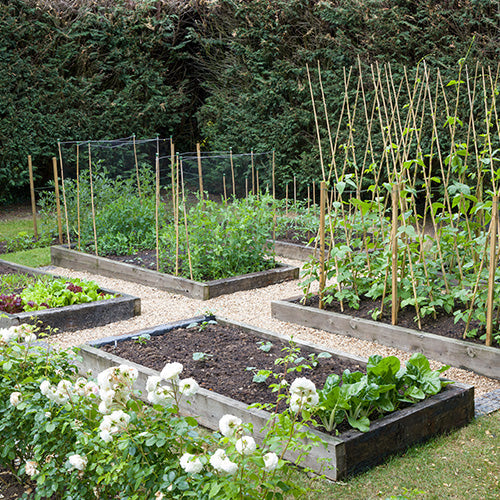If you’re wondering when to sow runner beans, you should do so from late May to the end of June, as this is when the last frost will occur. You should sow runner bean seeds 2in (5cm) deep and 9in (23cm) apart. It’s recommended to sow two seeds rather than one in case one fails to germinate, then thin out to leave the strongest seedling.
The traditional method of growing is to sow a double row with the two rows 18in (45cm) apart; this makes supporting the plants easier.
Alternatively, for an earlier crop, sow the beans in 4in (10cm) pots at the end of April indoors, in an area with a good amount of light. Seeds will germinate and grow very quickly in around one week, so ensure they are regularly watered during this time.
When plants are at least 4in (10cm) tall with a minimum of two leaves, harden them off for about 7 to 10 days, gradually exposing them to outdoor conditions. Once acclimatised, they can be planted out, 9in (23cm) apart, if there is no risk of frost. Be sure not to keep them in their pots for too long, however, as their stems and vines can become tangled with neighbouring plants.
Support
Runner beans need a support to climb up. The traditional method is to grow them individually up inwardly sloping 8ft (2.4m) bamboo canes, tied near their top to a horizontal cane. If you angle the bamboo canes so that they meet and are tied together at the top, with the ends of the canes extending beyond the row, it will make picking the beans easier and usually result in a better yield.
When growing in beds and borders, a pea and bean wigwam of canes takes up less room and helps produce an ornamental feature. Loosely tie the plants to their supports after planting; after that they will climb naturally. Remove the growing point once the plants reach the top of their support.
Growing in Pots
If you’re limited on space, you can grow runner beans in seed pots. Runner bean plants will grow just as vigorously in pots as they do in plots, so are an ideal choice for smaller growing areas. There are several options for dwarf bean plants for runner beans that especially lend themselves to being grown this way.
The pot should be large enough to provide enough support and stability for the plants. For dwarf runner bean plants, this is 12-18in (30–45cm) wide. Climbing runner beans will need a pot 30in (75 m) wide and 18 in (45cm) deep, with a wigwam of 8ft (2.4m) canes inserted for support.
Sow the seeds 2in (5cm) deep and 6in (15cm) apart into compost in their pots. Sow two seeds at the bottom of each cane and thin out to leave the strongest seedling.

 How to Grow Runner Beans
How to Grow Runner Beans

 Ground Prep
Ground Prep

 How to Sow Runner Beans
How to Sow Runner Beans

 Plant Care
Plant Care

 Harvesting
Harvesting

 Problems
Problems

How to Grow
Ground Preparation
Sowing
Plant Care
Harvesting
Problems

















1 comment
Chris Townson
Great tips , especially about the dwarf runners. I have a small garden so I grow them in a tall arch with our garden seat in the middle. It is very satisfying when the beans reach the middle ,dangle down so that I have to get on the seat to harvest .I get nomaly 2anda1/2 months harvest from them. Still just picking now !
Leave a comment
All comments are moderated before being published.
This site is protected by hCaptcha and the hCaptcha Privacy Policy and Terms of Service apply.